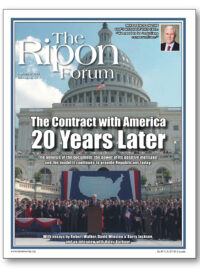 In the months leading up to the 1994 Contract with America, then Republican House Whip Newt Gingrich used the pollster he trusted most to develop the content – himself. Yes, the Gingrich team conducted a handful of focus groups but the bulk of the public opinion input that drove the Contract’s 10 major points derived from media and think tank survey research not from an extensive internal research effort. In reality, it was Gingrich working with his conference who zeroed in on the American people’s priorities and opted for a different path.
In the months leading up to the 1994 Contract with America, then Republican House Whip Newt Gingrich used the pollster he trusted most to develop the content – himself. Yes, the Gingrich team conducted a handful of focus groups but the bulk of the public opinion input that drove the Contract’s 10 major points derived from media and think tank survey research not from an extensive internal research effort. In reality, it was Gingrich working with his conference who zeroed in on the American people’s priorities and opted for a different path.
After 40 years in the political wilderness, Gingrich and company decided to reject the old campaign maxim that all politics is local. They looked at what the American people were concerned about and created an idea-based vision that reflected those concerns. In other words, they made a key strategic decision to nationalize the election but Gingrich understood that nationalizing the debate wasn’t enough to win. Republicans needed to offer people real solutions to real problems.
He embraced the idea that voters want something to vote for not simply a reason to vote against the other candidate or party. The Contract was more doctrine than a communications message. It offered voters change that could actually happen and would work. It was a realistic, doable political document that served as an organizing principle for a radical change in campaign strategy.
The Contract offered voters change that could
actually happen and would work.
1994 was all about issue content and political context for candidates and voters. It gave candidates the ability to talk in national terms about bigger picture issues and gave the Party consistency across districts. It also helped the Party develop the financial resources to win the kind of historic victory Republicans would need to take control of the House.
There were plenty of naysayers, much like today, who rejected issue content out of hand, favoring instead the old-school negative campaign strategy. In the world in which they operate, their advice to candidates was wholly predictable: “Don’t tell voters what you would do. That only gives Democrats something to shoot at. Just run against (insert Democrat candidate of choice) and you’ll be fine.” In the 20 years since the Contract, that kind of strategic thinking has characterized a growing list of failed Republican presidential and congressional campaigns.
With the Contract’s 20-year anniversary upon us, the debate over the effectiveness or wisdom of the Contract will no doubt resume. Few polls tested the Contract before the election and, unfortunately, the media’s post election polls didn’t measure the Contract’s impact on voters’ decision-making. But a Newsweek survey taken December 27-28, 1994 found that 64% of people favored the proposals contained in the Contract. Clearly, Gingrich had correctly identified people’s concerns with most of the Contract’s individual provisions getting favorable ratings above 70% in the poll – one of Gingrich’s litmus tests during the creation of the Contract.
But, perhaps, the strongest argument for the Contract’s idea-based strategy is a brief analysis of the off-year campaigns since. Four years after the Contract victory, Republicans once again tried to nationalize the election by adopting a “Don’t reward Clinton” strategy, but unlike 1994, they failed to give voters a reason to vote for them. That strategic decision cost Republicans five House seats and Gingrich his Speakership.
Voter sentiment in 2002 was driven by 9/11. 2006 saw Republicans lose the House without a strategy to combat an increasingly unpopular president of the same party. Only one off-year election truly replicated, in fact, exceeded, the Contract’s success by returning to an idea-based, nationalized campaign – the 2010 election for the House embodied by the Pledge to America.
House Republicans developed the Pledge in response to the leadership’s decision to nationalize the 2010 election. House leaders understood, as Gingrich had, the need to define what a Republican majority would mean for people and their concerns.
Only one off-year election truly replicated, in fact, exceeded, the Contract’s success by returning to an idea-based, nationalized campaign – the 2010 election for the House embodied by the Pledge to America.
“Where are the jobs” became the question that defined this strategy. In post election data done by The Winston Group, 77% of those surveyed said “where are the jobs” was the central question of the election. If “where are the jobs” was the meat, the Pledge was the bones of House Republicans’ national strategy.
While there is scant polling data to measure the Contract or the Pledge’s impact, a better measure may be looking at electoral outcomes. In both 1994 and 2010, House Republicans chose to adopt a national strategy grounded in a set of core principles and represented by a series of issue-based solutions. In 1994, House Republicans picked up 52 seats defeating 35 Democrat incumbents. In 2010, House Republicans won 63 seats beating 52 sitting Democrats in the process.1
But in those same elections, Senate Republicans opted for traditional, more negative campaigns that put GOP candidates, especially those trying to unseat Democrat incumbents, at a disadvantage. The results are in stark contrast to House successes. In 1994, Republicans defeated only 2 Democrat incumbents picking up a total of 8 seats. In 2010, again the GOP could only manage to win 2 Democrat seats and 4 open seats for a gain of 6.
Those same naysayers that rejected the Contract in 1994 were proven wrong once again in 2010 when House Republicans offered voters another idea-based vision with the Pledge to America.
The Contract taught us that when people are unhappy with current political leadership, they are willing to listen to an alternative. Newt Gingrich understood that what that means is Republicans have to have something to say. Telling voters what you get with a Republican majority worked in 1994. It worked again in 2010. It can help assure a Republican victory in 2014 for those who are willing to step up and tell voters what they stand for and what specifically they will do to address the nation’s challenges.
___________________________________
David Winston is the president of The Winston Group, a strategic planning and survey research firm. He has served as a strategic advisor to the Senate and House Republican leadership for the past 10 years, and was formerly the Director of Planning for Speaker of the House Newt Gingrich.
1. Brookings Institute and the American Enterprise Institute, Vital Statistics on Congress, Tables 2-3, 2-4, 2-5, 2-6.




